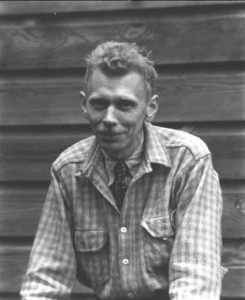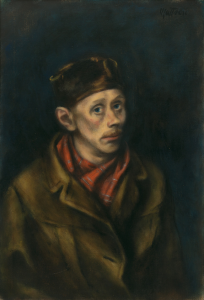

Biography
Henry Mattson was born in Gothenburg, Sweden (1887) in comfortable circumstances. His father worked to design and test locomotives, for which he had been decorated by the king. His mother maintained a simple household, typical of Swedish style in that era. Her simplicity may have influenced the style of Mattson's later artistic works. While he did not spend a lot of time on art as a child, he did attend museums and at one point encountered a Signac work that made him resolve to eventually become an artist.
In 1905 Henry emigrated to Boston, MA, joining his brother who was already living there. After a few months he moved to Worcester, MA, attracted by its large Scandinavian population. He worked in a succession of factories, the first of which interestingly manufactured pigments for paint. Seeing an attractive paint box in a shop window, he acquired some materials and began painting on weekends.
In 1912 Mattson took evening classes in cast drawing at the School of the Worcester Museum. But his drawing skills were regarded as inadequate for promotion to live drawing classes. In 1915 he attempted to study at Valand's painting school back in Gothenburg. But here, too, he was rejected as an inadequate draftsman.
Returning to the United States, Mattson got factory jobs in Chicago, eventually becoming a foreman at International Harvester while painting in the evenings. He moved to Plainfield, NJ and did more factory work in 1915. He often spent lunchtime at the International Plainfield Motor Company talking about art with a co-worker. Through this connection, Mattson met the painter Jonas Lie, who encouraged him to pursue a career in art. He also learned about the summer classes at Woodstock taught by John F. Carlson, a Swedish artist who had married a Plainfield woman.
In 1916 Mattson moved to Woodstock for what turned into a permanent stay. Like many Woodstock artists, Mattson was initially a resident only in the summer months, but by the mid-1920s he had settled there for good. His lessons with Carlson were short-lived. As with his other formal teachers, there was a conflict between Carlson's demands for technical proficiency and Mattson's inclination to let his compositions flow out of the media with which he was working.
For a while Mattson commuted to Manhattan to work as a mechanic. And for years he did odd jobs in Woodstock, such as landscaping and teaching at a private school, before being able to commit to full-time work as an artist.
Mattson's first exhibitions included a role in a Swedish-American traveling exhibition in 1920 and a small solo show in New York in 1921. The solo show did not attract much attention, but Mattson gradually gained recognition, with exhibitions in the U.S., London, Paris and Italy.
Mattson's paintings in the 1920s were mostly rural landscapes. He used one dominant color and simplified shapes, with occasional skewed perspectives, blending the edges of his brush strokes. This was a style adopted by other artists in Woodstock, coming to be known by critics as the Woodstock fuzz technique.
In 1933 Mattson began to paint seascapes - either as a reaction to being pegged as an Regionalist for his rural landscapes or from some sort of nostalgia for his Swedish homeland. He continued to produce mostly seascapes for the next 15 years.
During the 1930s Mattson taught in Woodstock and worked for the Public Works of Art Project. His work began to be broadly recognized, including the Clark Prize at the Corcoran and a Guggenheim Fellowship for Creative Arts in 1935. In 1937 he completed a fresco for the Portland, ME Post Office.
Mattson's work was included in a 1946 exhibit of two centuries of American painting at the Tate Gallery in London. And in 1950 he received a gold medal from the Pennsylvania Academy of Fine Arts. But as abstract expressionism began to hold sway over the art world in the 1950s, Mattson's style began to look old-fashioned. His one-man exhibitions at the Rehn Gallery in New York in 1956 and 1959 were to be his last, and he was said to have been embittered by the shift in public taste. He died of pneumonia in a Poughkeepsie hospital in 1971.


Critical Analysis
For many artists, participation in the federal art programs of the 1930s involved major compromises. A majority of the painters commissioned to produce Post Office murals would probably have preferred to paint more abstract works, but they were constrained by the very conservative tastes of the program administrators. Of course, with no other work available, they were grateful for the income provided by the government and submitted to the artistic limitations it demanded.
Mattson was different, in that his fresco for the Portland, ME Post Office is very much of a piece with the other seascapes that he was producing at the same time. This was because Mattson's style was somewhat abstract, but not so abstract as to bother conservative critics of the era.
While Mattson's seascapes can easily be read as representational, this is not how they evolved from Mattson's brush. He resisted even having a definite subject for his work. Rather he started to put paint of the canvas and let the subject evolve from the structure of the paint. This approach led critics to a number of interpretations. He was variously described as mystical or romantic, with a kinship to the artist Albert Pinkham Ryder, whose influence was fairly broad. He himself likened his approach to Chinese calligraphy, emphasizing the rapid and smooth way in which his compositions would evolve.
This approach proved to be a popular one in the 1920s and 1930s, and Mattson was able to support himself solely from sales of his paintings during this period. As abstract expressionism swept the art world in the 1950s, however, his work went rapidly out of fashion. Of course fashion is one thing - and quality is another. Mattson's canvases still stand out for their simplicity, clarity and boldness.
Murals
- Portland, Maine - Post Office: The Rocky Coast of Maine
- Portland, Maine - Post Office: The Sea
References
- Henry Mattson (askART).
- Henry Mattson (Wikipedia (Swedish)).
- Henry Mattson (Swedish-American, 1887-1971) (Swedish-American Works from the Hillstrom Collection).
- Bruce Weber, Henry Mattson, Master Marine Painter of the Woodstock Art Colony, Learning Woodstock Art Colony April 6 (2024).
- Mary Towsley Swanson, Henry Mattson: Swedish-American Painter of the Seas, Swedish-American Historical Quarterly Volume LII:3 (July) (2001).